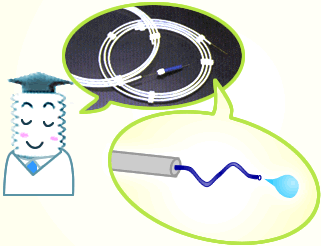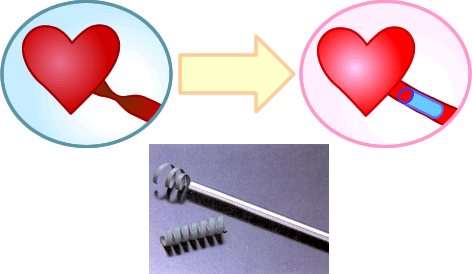
Episode 14: “Springs in Medical Field”
Hello everyone. I hope you have a very good 2008.
After a hot summer, this cold winter means the amount of cedar pollen in the air will be two to three times that of normal years, and pollen is being dispersed even in January. Take care if you get hay fever.
Although cedar pollen is too small to be seen by the naked eye, it is significantly affecting more people who are becoming increasingly allergic to it; the human body is mysterious indeed.
So today, let’s talk about springs used as medical technology in the body. Spring catheters and stents have significantly improved recent endovascular treatment as our “elastic body microfabrication technology” is used in the latest medical fields. In Japan’s aging society, “patient-friendly” treatment is sought for people with reduced physical strength. Therefore, the present trend is to use “endovascular treatment with a catheter” or “endoscope techniques”, which do not need a major operation.
 |
The tip of the spiral catheter developed by Piolax Medical Devices, Inc. uses spiral shape-memory alloy. It is brought near the affected organ and then the tip is attached to a blood vessel to administer powerful drugs, such as anticancer agents, to treat only the target part. This unique feature of the spiral catheter is gaining a good reputation in chemotherapy for treating liver cancer, etc. |
Also, the spiral catheter uses our unique coating technology, which slides easily when in contact with saline or blood, allowing the catheter reach the affected part without damage. Unlike the coating of biologic origin, this synthetic coating also ensures there is no risk of cross infection from agents, such as viruses, prions, etc.
The stent is an in-dwelling device used to open-up constricted blood vessels, the trachea, digestive tract, etc., to improve the flow of blood, air, and digestive fluids.

The stent of Piolax Medical Devices, Inc. uses microfabricated shape-memory alloy and is mounted at the tip of the delivery system (usually an endoscope) in a compact sheath just 2.3 mm in diameter. When the stent reaches the constriction, the sheath is removed and the stent springs open to its original diameter (6 to 10 mm), widening the constricted part.
As with automobile parts, the materials used in these medical springs are carefully selected and include stainless steel, shape-memory alloy (Ni-Ti), and synthetic resin.
It’s surprising how springs are even being used in our bodies to keep us healthy, but there is nothing more valuable than good health.
That’s it for now, but let’s talk about sports and the spring next time (because the 2008 Beijing Olympics will soon be here).
See you.
Written by Banekko (a child of spring)

